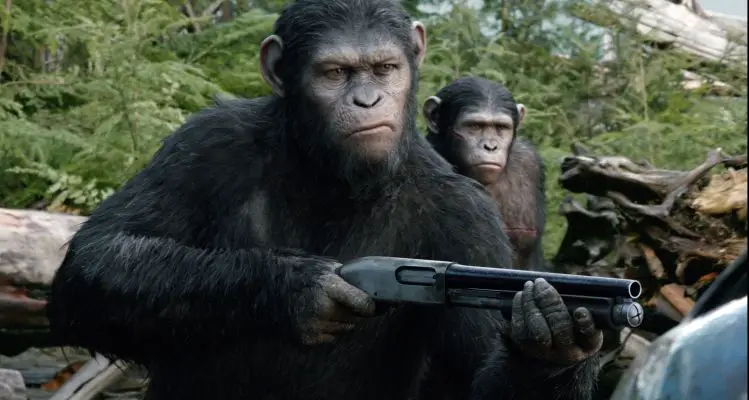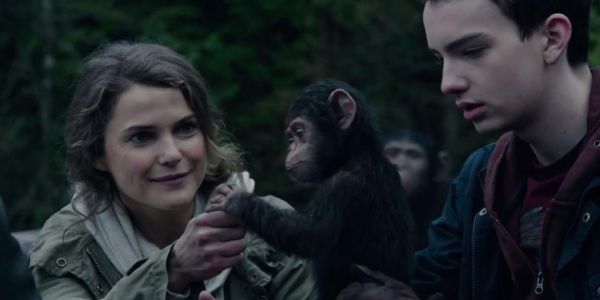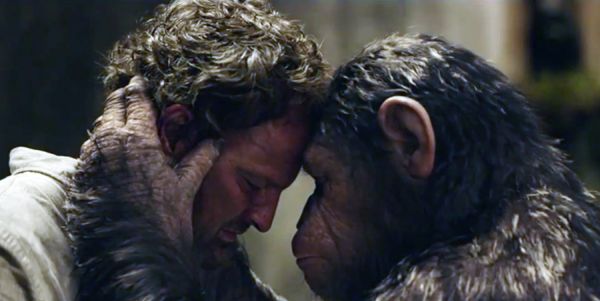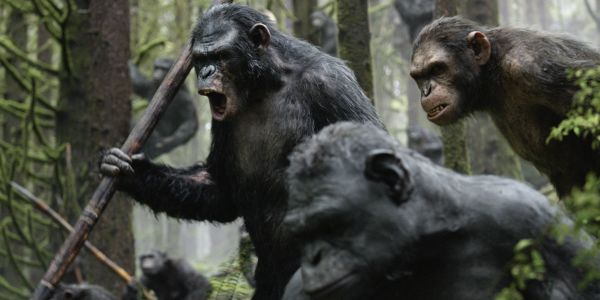DAWN OF THE PLANET OF THE APES: An Exceptional Blockbuster

Manon de Reeper is the founder and CEO of Film…
Dawn Of The Planet Of The Apes is the sequel to Rise Of The Planet Of The Apes (2011), which heralded the latest reboot of the Planet Of The Apes franchise. Dawn presents a story much more intelligent than you’d expect of a blockbuster, its creators having put an overwhelming amount of effort into creating a world that is believable, into creating a wholly new culture for characters that are unique and relatable, furry or not. Rise was good, but Dawn is even better.
The movie opens with news footage that show the end of the world as it happens. The world is infected with the ALZ-113 virus, which spreads and kills fast. If you’re familiar with the Pandemic (or Plague Inc.) game, you’ll recognize the similarities between the game and the spreading of the disease in this movie: the world quickly starts to collapse as humanity is unable to fight this powerful disease; governments fall, bodies are burned, martial law is imposed, and finally, before almost everyone’s dead, anarchy. In any case, the image Dawn sketches for our apocalypse isn’t a pretty one.

In Dawn, we find out there are still human survivors living in San Francisco. Caesar (Andy Serkis), lead chimp of the Rise film, has risen to the rank of leader of his enormous pack of chimpanzees, gorillas and a solitary orangutan, who live together in a village in the mountains just outside of San Francisco. When the humans are exploring the mountains in search of a power source (an old dam), they stumble upon the apes. The apes scare them off and the humans flee back to the city. A conflict arises: the people of the city want access to that dam as they’re running low on power and resources, but the apes soon come to the city to make clear that they don’t want the humans in their forests, and are prepared to fight, but prefer not to.
To Fight Or Not To Fight
Dreyfus (Gary Oldman), the leader of the people in San Francisco, wants to fight; they need that power source, and they need it now. The people of their group want to fight as well, however, one man, Malcolm (Jason Clarke), proposes that he will go into the apes’ camp to propose a treaty, to see if they can work together without bloodshed. Malcolm appeals to his friendship with Dreyfus, and the latter allows him to try out his plan, but gives him only three days to carry it out.
With a group of people, among them his son (Kodi Smit-McPhee) and post-apocalypse-found wife (a former CDC doctor; Keri Russell), Malcolm ventures into the woods and politely asks Caesar for permission to access the dam. Caesar, familiar with humans and having been taking care by a good one in the past (Will Rodman – James Franco – in Rise), is inclined to allow them. However, there are apes in his camp that have a far less great experience with man, most dominantly his sergeant-at-arms, the violent, cunning and previously tortured laboratory chimpanzee Koba (Toby Kebbell). Koba wants the humans to stay away from them, and actively fights Caesar on the matter.
Animals Versus Humans
In most films that put animals – or nature in general – in a situation where they have to fight humans, the human race is cast as the evil villain. We people destroy the world, and the poor animals have to give everything to battle us, while we simply squash them with our heavy machinery. It’s an oft recurring convention (think Avatar, Rio 2, Godzilla, Pom Poko, et cetera ad infinitum). What makes Dawn interesting is that not one camp is cast as the villain: there are ape and human sympathizers in both camps, just like there are ape and human haters in both camps. I must applaud the screenwriters (in this case, Mark Bomback, Rick Jaffa and Amanda Silver) for going where so few others attempt to go.

Their risk wasn’t in vain: this lack of a general villain makes for a much more refined story, allowing all characters to make their own choices. Each character, human or ape, has his or her own set of morals, experience and back story. The amount of detail put into each character is impressive. Ultimately, Koba is the villain of the story, but the apes realize it as much as the humans do. With Koba, however, they creators added another shade of gray: he made his decisions based on his past experiences with humans. While the filmmakers don’t slam you over the head with it, you’re left with the question whether or not the humans are the villains after all: did they not induce Koba’s behavior to begin with? I can always thoroughly appreciate this kind of moral questioning of the audience.
Culture: Not Just For Humans
The apes of Dawn live in a village – the many cottages are hand-built. They practice art and wear jewelry. They have developed to the point where they communicate through sign language and spoken English. It’s incredibly realistic – big parts of the film are silent, where the monkeys merely communicate through sign language, the language they prefer. When the monkeys do speak, you can tell they aren’t accustomed to it; it costs them a significant effort to produce the sounds. They are hyper-intelligent: they read and write, are very capable planners and schemers and have an understanding of the world perhaps even better than our own.
And yet, typical ape behavior shines through abundantly: multiple times, the apes are shown to defer to Caesar, or ask them for forgiveness, by offering him their hands. If Caesar accepts it, he acknowledges them and their request. It’s not as if the apes have become more like humans – they haven’t been anthropomorphized: their culture is a wholly uniquely developed one, having only lent from humans what they found useful (e.g. language, house building, weapons, riding horses). The same counts for the apes’ movements; they don’t move more human-like. They are apes first and foremost.

Furthermore, the apes haven’t been made to look kinder, or prettier, than real apes do – which look rather menacing (admittedly, I’m not a fan of monkeys or apes – they scare me). Even Caesar looks menacing, although he may be accused of having been made to look a bit more handsome than his fellow apes. As I see it, the makers still wanted the audience to relate with him and we’re more prone to trust and relate to a good-looking leader, even when it’s a monkey – it’s basic human psychology.
The level of detail and nuance and the amount of effort that has been put into the creation of the apes’ culture are overwhelming and incredibly impressive. I can’t think of another movie that did creating a culture for a non-human species as well as Dawn has – so often species are anthropomorphized and/or stereotyped.
Don’t Forget About the Explosions
Dawn would have already been a pretty unique and good movie with the interesting elements I discussed above. However, Dawn isn’t just a discussion of cultural matters. It’s also still an action flick and a blockbuster, and so, the audience is confronted with a massive amount of uprisings, coups, explosions, collapses, apes riding on horses while shooting automatic rifles or rocket launchers (it’s as far-fetched as it sounds, but it’s still sort of cool)… It’s not a bad thing. I can enjoy a good action flick. But what made me love Dawn is that the the meaningful cultural observations and die-hard action are so well-balanced. It makes the movie accessible to a wide spectrum of film-goers, both the “just give me explosions” and “just give me an intelligent movie” segments of the audience will appreciate this one.
The technical feats alone are a reason to see this film too. The animation is astounding: no actual apes play in this movie – just remind yourself of it while you’re watching – the animation is that good. The score (composed by Michael Giacchino) is beautiful and befitting of the scenes at all times. The cinematography (Michael Seresin) is great, each shot well thought out.
As for the actors, Jason Clarke as Malcolm was perfectly believable as the somewhat nerdy do-gooder who wants to avoid war. Gary Oldman, as Dreyfus, was a bit of a needle scratch for me – his character was the only one to me that came across as stereotyped, and part of that had to do with his bland performance. Yet, the highest praise has to go to the three actors that stood out most: Andy Serkis as Caesar, Toby Kebbell as Koba and Nick Thurston as Blue Eyes. Their performances made this movie – if the apes weren’t convincing, it would have failed no matter how good the rest was.

Director Matt Reeves should be proud: he created an excellent movie that worked on every aspect. Planet of the Apes has proven to be a bit of a tough franchise to reboot (Tim Burton‘s entry was far from a success), but Reeves has added a movie that has made me very excited to see more.
All in all, if it weren’t obvious yet, I’d recommend you see Dawn of the Planet of the Apes. It’s worth your while.
If you’ve already seen Dawn, what did you think? What did you think, in particular, of the extent the creators went to create a culture for the apes?
Share your thoughts below – let’s discuss!
Does content like this matter to you?
Become a Member and support film journalism. Unlock access to all of Film Inquiry`s great articles. Join a community of like-minded readers who are passionate about cinema - get access to our private members Network, give back to independent filmmakers, and more.
Manon de Reeper is the founder and CEO of Film Inquiry, and a screenwriter/producer. Her directorial debut, a horror short film, is forthcoming in 2021.













